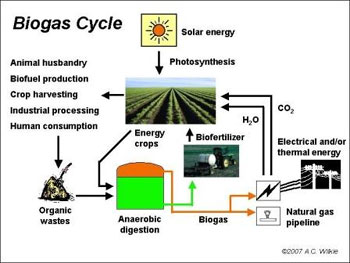The US dairy industry’s goal is to cut greenhouse gas emissions 25% by 2020, and the US Department of Agriculture (USDA) signed an agreement this week to help them achieve that.
Large dairy companies contribute 4% of the world’s greenhouse gas emissions, according to the Food & Agriculture division of the United Nations.
USDA signed a 3-year agreement with the Innovation Center for US Dairy, which represents the industry. USDA will develop a "roadmap for biogas," a key technology for converting farm waste to clean energy, which makes fertilizer as a by-product.
The agreement extends their collaboration, which began in 2009, to improve the sustainability of dairy operations.
Also known as anaerobic digesters, the natural gas derived from farm waste, such as manure, along with landfills and wastewater treatment plants could provide 4%-10% of the current US demand for natural gas … without the fracking.
When upgraded to pipeline quality, biogas can be used in many different applications – from space heating and cooking, to electric power production, to transportation fuel. And it can be shipped through the existing, extensive natural gas pipeline grid.

Methane is the largest source of greenhouse gases in the US after carbon and is 21 times more potent. Much of it is emitted from landfills, livestock manure management, and sewage. Capturing it and converting it to useful energy can address multiple economic, energy, environmental and climate concerns.
As of 2009, just 2% of large dairy operations had anaerobic digesters.
In 2008, the industry launched the US Dairy Sustainability Initiative "to accelerate innovation and build public trust in the industry’s commitment to providing consumers with the nutritious products they want in a way that is economically viable, environmentally sound, and socially responsible."
Through the Innovation Center, leaders from 80% of the dairy supply chain – including dairy farmers, coops, associations, processors, manufacturers, and brands – have endorsed this commitment.
In 2009 they established a goal and Roadmap for the entire value chain to reduce greenhouse gas emissions 25% by 2020.
Since then, USDA has awarded about 180 grants and loans to finance biogas systems and 140 for other kinds of clean energy on farms.
Read Farms Offer New Market for Renewable Energy.

It’s very important to get the methane produced by cows under control as you stated in your article. It’s a huge contributor to Greenhouse gasses. I wonder if you can research and report on a comparison between the agricultural methane problem and the oil and natural gas methane problem. I read a lot about how oil and natural gas exploration, particularly fracking is releasing so much methane that it’s making this Natural gas as bad as coal in terms of green house gasses and climate change impact. I’d loke to know more.
Yes, poor deer and also poor family who may one day cosumne it.I wouldn’t even try to estimate the cost to plug this well. It is in the Allegheny National Forest located approx.1600 feet from the nearest road.It is in a low lying area, off of (old) 321, along Kinzua Creek’s bank,near Westline,PA.To plug it,trees would have to be removed,a road would need to bebuilt and that road would have to be built through the wetlands.Plugging requires heavy equipment.Problem wells may and often do cost over $150,000-$700,000 to plug.I don’t have a clue how much it would cost to construct a road.In 2009 the DEP’s entire plugging budget was approx$390.000 for the year.There are hundreds of thousands of lost and abandoned wellsin Pennsylvania and many are similar to this one.This one is probably pouring MANY millions of cubic feet of methane into the atmosphere every year for decades.The DEP’s plugging program does try to plug as many unplugged wells as possible on their budget.Many lost and abandoned wells are just like this well or worse.This well will probably remain unplugged for the lifeof the planet.